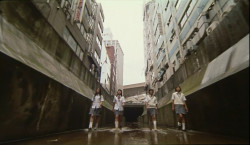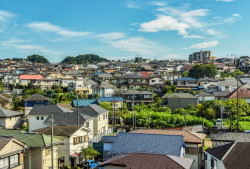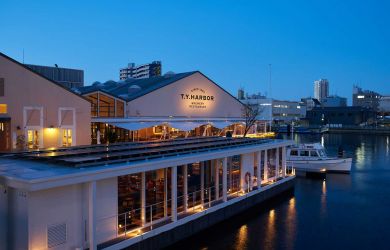
September 28, 2006
Kaleidoscopic Nikko
The fabled sightseeing destination comes alive in autumn
By Metropolis
Originally published on metropolis.co.jp on September 2006

Photos by Jeffrey Tanenhaus
Nikko requires little introduction to anyone who’s consulted a guidebook on Japan. The tourist magnet planted in Tochigi Prefecture’s wilderness is one of the best-known Tokyo daytrips. Urban dwellers are reminded that Nikko’s treasures are the essence of Japan, thanks to a “Nikko is Nippon” and “Premium Japan” poster campaign papering metropolitan train stations.
Nikko does indeed host an idealized vision of old Japan. Ornate carvings embellishing temples and shrines, sculpted trees and moss-covered statues make it a storybook setting of a bygone era—the early 17th century to be exact. That’s when the grandson of Tokugawa Ieyasu rebuilt a simple shrine honoring the shogun, who was the final unifier of Japan. Ever since, Tosho-gu Shrine has been the arresting jewel in Nikko’s crown.
The Nikko-San’nai area is one of Japan’s 13 World Heritage Sites. In 1999, UNESCO recognized Nikko for the artistic genius of Edo craftsmen and its majestic setting, which reinforces Shinto’s spiritual core belief of revering nature. Visitors of any denomination will agree that the forest feels hallowed.
Nikko, which means “sunlight” in Japanese, shines year round. There’s no untimely season to visit, but there is a timely one: autumn. Around early November, a blazing backdrop enhances the beauty of Nikko’s architecture. Peak koyo season features flaming trees and bushes landscaped around red lacquered shrines and burgundy temples.
The sun warmed my hands on a visit during a crisp day last November. The sky was a canvas of blue and white; leaves radiated red, yellow, orange and green. Like theater spotlights, bursts of sunshine illuminated fall in its most colorful moment, sharing a stage with some of Japan’s most acclaimed attractions.

One of the most photographed of these is Shin-kyo Bridge. This “sacred bridge,” with its characteristic vermillion hue, elegantly spans the Daiya River, and marks the gateway to Nikko’s shrines and temples. But it wasn’t always wooden. Legend has it that snakes divinely appeared here to enable priest Shodo Shonin, founder of Buddhism in Nikko, to cross the river. Snakes, in fact, would justify Shin-kyo’s billing as “one of the three most unusual bridges in Japan.” Forego the admission fee, but snap an obligatory photo from the shoulder of the nearby highway.
Rinno-ji Temple first greets visitors walking north from Shin-kyo. The salient Three Buddha Hall is Nikko’s largest building, housing—yes—three gilded wooden Buddha statues. A separate fee allows access into the temple’s treasure house and Japanese garden. Leaving Rinno-ji through the west gate, a wide path leads to Tosho-gu. On the way, a five-story pagoda pierces the canopy of cedars. Zodiac images adorn this colorful 36-meter-high structure, which was presciently engineered in 1819 to withstand earthquakes.
A stone torii leads to the lavish precincts of Tosho-gu. With more than a dozen buildings drawing on Shinto, Buddhist and Chinese designs, the mausoleum is monumental in size but meticulous in detail. Be prepared to spend time in line admiring the fine woodcarvings, including Nikko’s most beloved: the monkeys above the Sacred Stables. These wise primates depict the “hear no evil, speak no evil, see no evil” moral tenet of Tendai Buddhism familiar to Japanese of all ages.
More intricate craftsmanship is on display at Yomeimon (or Higurashinomon). The Chinese-influenced Gate of Sunlight (or Twilight) is dually named because viewers can spend all day admiring its 500 carvings of animals and spiritual creatures.
Nikko’s oldest structure, Futarasan, stands west of Tosho-gu. Rebuilt in 1619, this Shinto shrine is dedicated to the area’s three holy mountains. West of Futarasan is Taiyuin-Byo. Here lies the tomb of Tokugawa Iemitsu, the third Tokugawa shogun, who commissioned Tosho-gu for his grandfather Ieyasu. Although intentionally more modest than Tosho-gu, Taiyuin-Byo is just as impressive. Towering cedars filter sunlight and shield this impeccably designed complex from too many visitors.
Wind down a day of temple-hopping with a stroll beside the small rapids of the Daiya River. A leisurely trail along the Ganman-ga-fuchi abyss leads through a stone park lined with about 70 weathered statues of Jizo, the guardian deity of children and travelers.
Those with an extra day should spend it in the nearby Lake Chuzenji, where mountains, marshes, plateaus, lakes and waterfalls reward even the casual hiker. Because of the higher elevation, the leaves change here in early- to mid-October, weeks earlier than in Nikko.
Harmony abounds in the city of sunlight. Shinto shrines and Buddhist temples coexist in a forested setting where nature reigns supreme. “Don’t say ‘magnificent’ until you’ve seen Nikko” is a Japanese expression especially apt in autumn.
Time your trip right by tracking the foliage front at www.walkerplus.com/koyo. Travelers with a tourist visa can pick up a World Heritage Pass at the Tobu Sightseeing Service Center near Asakusa station (03-3841-2871). Valid for two consecutive days, the coupon (¥3,600) includes a round-trip ticket on a rapid train (about 2hrs, 15min one-way), admission to Tosho-gu and Futarasan Shrines and Rinno-ji and Taiyuin-Byo Temples, and a bus pass from the station to the shrines. Notable October festivals include the Nikko Kekko Festival (date TBA), the autumn fireworks display (date TBA), yabusame (archery on horseback, October 16), and the annual festival at Tosho-gu Shrine with 1,000 colorfully costumed participants (October 17).
[geo_mashup_map]







